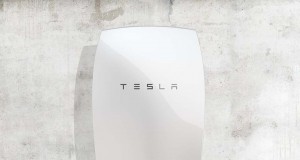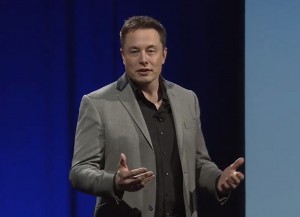
Tesla's building the largest lithium-ion storage project in the world, which is just a bit larger than this Powerwall unit.
Once again, a State of California directive works out to Tesla’s gain. The company best-known for its high-price electric vehicles was selected help solve the state’s power problem.
In 2013, the California Public Utilities Commission mandated that investor-owned utilities have a combined target of 1,325 megawatts of energy storage online by 2024. With that, in stepped Tesla Energy.
The storage arm of Tesla has been selected to build what it calls the largest lithium-ion battery storage project in the world. It will hold enough electricity to power 2,500 households for a day or charge 1,000 of its vehicles, the company said on its blog.
Of course, that capability accounts for just 20 megawatts of the more than 1,300 the commission is pushing for, but the project has to start somewhere. It also helps provide additional business for the company’s massive Gigafactory near Reno, Nevada, which produces a variety of the batteries.
(Click Here for more about Tesla, Mobileye pointing fingers at each other.)
Tesla officials did not release the value of the deal, but according to the company’s website, a 2-megawatt Tesla battery system costs about $2.9 million, and any contracts greater than 2.5 megawatts must be negotiated directly with the company.
While Tesla’s involvement may bring a lot of attention, it isn’t the only company participating. In August, California regulators approved two contracts for AES Corp. to build 37 megawatts of grid-scale energy storage systems, according to Bloomberg. Canadian energy company AltaGas Ltd. also won a 20 megawatt contract with Southern California Edison to be completed this year.
Tesla expects the grid to be completed by 2016. Southern California Edison owns the substation.
The contract is part of a state-mandated plan to improve grid reliability. While originally ordered in 2013, the plan shifted into overdrive after the massive leak at a natural gas well in Aliso Canyon threatened power supplies.
(Shareholder files suit to halt Tesla acquisition of SolarCity. For more, Click Here.)
The system is important because without it, all solar power-generated electricity in the state must be used at the time it is generated. Often that is not the moment when it is most needed. By sending power to the batteries instead, the power can be discharged when the sun isn’t shining or when demand in peaking in the hot, late-afternoons when air-conditioning units are running full out.
California isn’t the only place where Tesla’s impact is being felt when it comes to energy storage. The company is trying to forge a similar relationship with farmers in Australia. The nation was the first Tesla Energy market where there has been high demand for solar and battery storage production, according to ABC Rural, a division of Australia Broadcast Co.’s news organization.
Tesla has started targeting the local farmers, who have been some of the buyers of Solar City – soon to be part of Tesla Energy – suggesting that they could also be capable of storing energy, adding that being at the forefront of business trends isn’t unusual for the farers.
“The history of innovation in Australia is really impressive. The scene is basically set to drive that in the next couple of decades. I think it could be a massive area of growth.” said Nicholas Carter, Tesla Energy training manager of Powerwall, at a recent agribusiness event in Melbourne, Australia.
(To see more about why Tesla is raising cash, Click Here.)
He said that while storage and solar energy are taking on diesel as an electricity source, it is providing more options to farmers in the country. He thinks that Australian farms have the space advantage compared to those in Asia and Europe.

